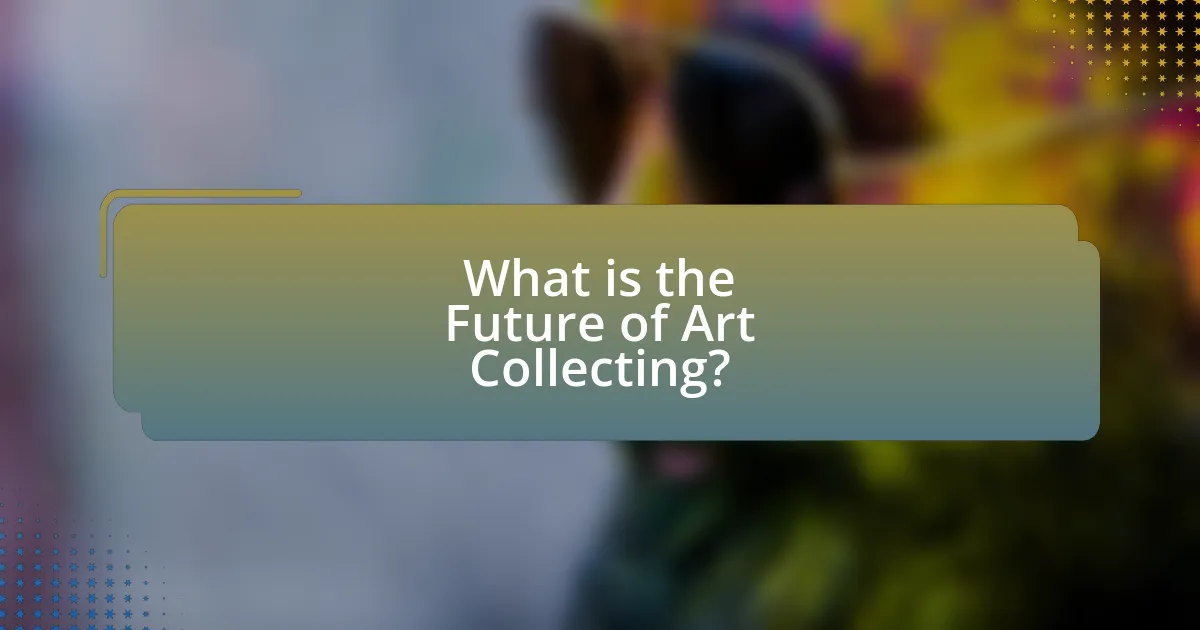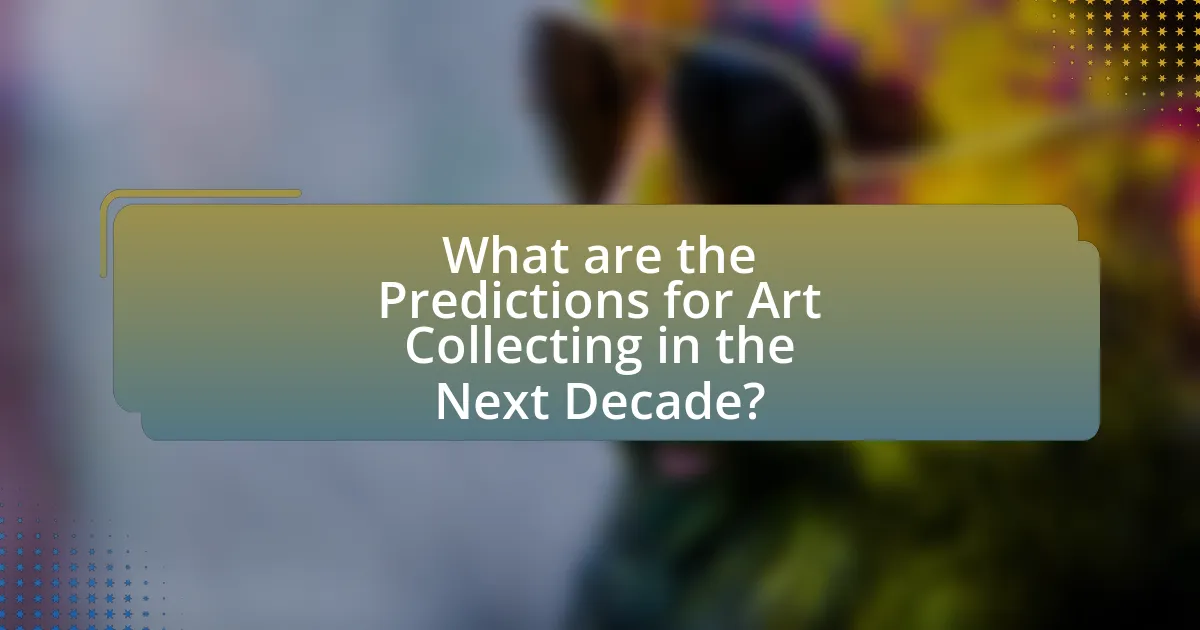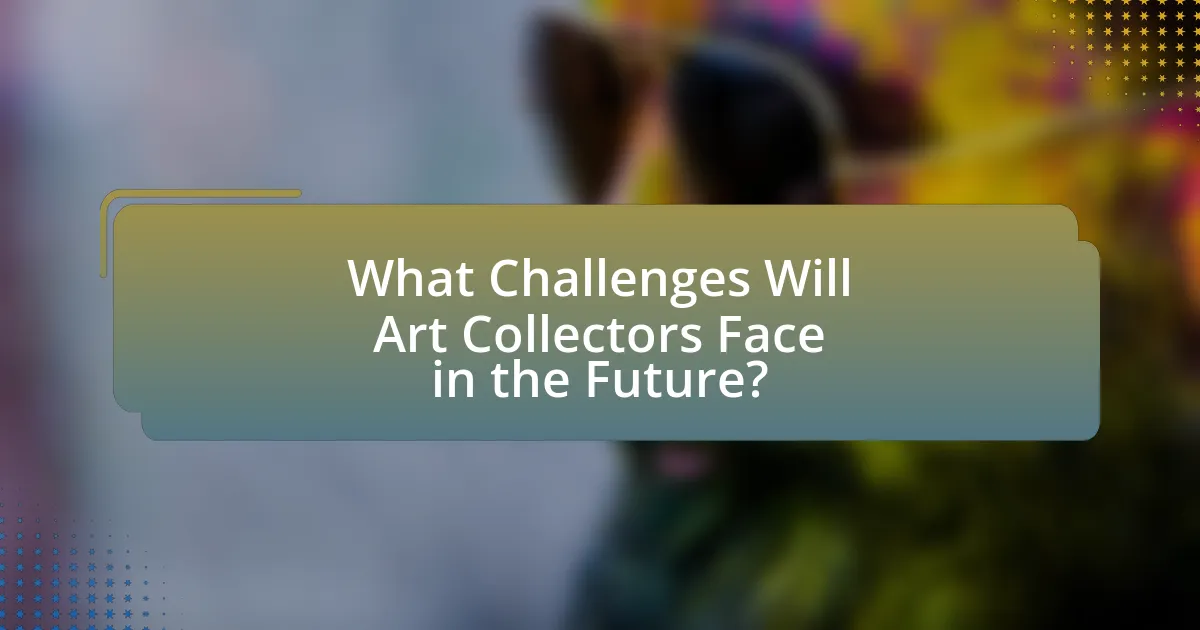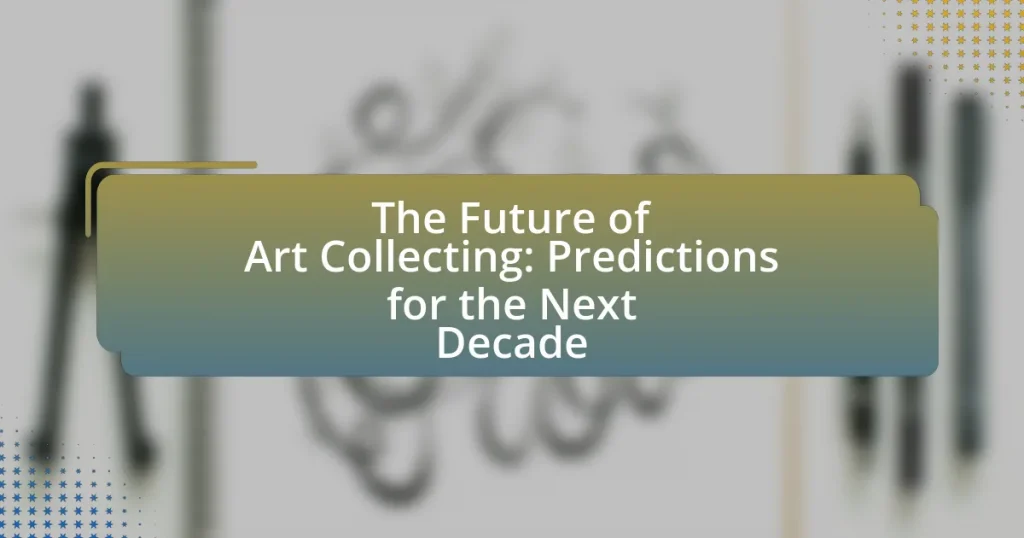The article focuses on the future of art collecting, emphasizing the impact of digital technologies and non-fungible tokens (NFTs) on the art market. It outlines how online platforms and blockchain technology are transforming the buying and selling of art, making it more accessible and transparent. Key trends include the rise of younger collectors, the integration of digital assets, and the influence of social media on art discovery. Additionally, the article discusses challenges collectors may face, such as issues of authenticity and cultural appropriation, while highlighting best practices for building diverse collections in an evolving market.

What is the Future of Art Collecting?
The future of art collecting will increasingly be shaped by digital technologies and the rise of non-fungible tokens (NFTs). As more artists and collectors embrace blockchain technology, the ownership and provenance of artworks will become more transparent and secure, allowing for a broader market reach. According to a report by Art Basel and UBS, the global art market reached $65.1 billion in 2019, and the integration of digital assets is expected to attract younger collectors, further expanding the market. Additionally, online platforms for buying and selling art are projected to grow, making art more accessible to a diverse audience.
How is art collecting evolving in the digital age?
Art collecting is evolving in the digital age through the rise of online platforms and the integration of blockchain technology. Online marketplaces like Artsy and Saatchi Art enable collectors to access a global range of artworks, facilitating transactions that were previously limited to physical galleries. Additionally, blockchain technology ensures provenance and authenticity, as seen in the sale of NFTs (non-fungible tokens), which have transformed how digital art is bought and sold. According to a report by Art Basel and UBS, the online art market reached $12.4 billion in 2021, highlighting the significant shift towards digital platforms in art collecting.
What role do technology and social media play in art collecting?
Technology and social media significantly enhance art collecting by providing broader access to artworks and facilitating connections between collectors and artists. Online platforms enable collectors to discover, purchase, and showcase art from around the world, breaking geographical barriers. For instance, platforms like Artsy and Saatchi Art allow users to browse extensive collections and engage with artists directly, which has led to a 70% increase in online art sales from 2019 to 2021, according to the Hiscox Online Art Trade Report. Additionally, social media channels like Instagram serve as vital marketing tools for artists and galleries, allowing them to reach wider audiences and build communities around their work. This digital engagement not only democratizes art access but also fosters a new generation of collectors who are more informed and connected than ever before.
How are online platforms changing the way art is bought and sold?
Online platforms are revolutionizing the art market by providing greater accessibility, transparency, and a wider audience for artists and collectors. These platforms enable artists to showcase their work globally, eliminating geographical barriers and allowing direct sales to consumers. For instance, according to a report by Hiscox, online art sales reached $12.4 billion in 2021, reflecting a significant increase in digital transactions. Additionally, blockchain technology is being integrated into these platforms, enhancing provenance verification and ensuring authenticity, which builds trust among buyers. This shift towards digital marketplaces is reshaping traditional art buying and selling practices, making them more efficient and inclusive.
What trends are shaping the future of art collecting?
Digital art and NFTs are significantly shaping the future of art collecting. The rise of blockchain technology has enabled artists to tokenize their work, creating unique digital assets that collectors can buy, sell, and trade. According to a report by Art Basel and UBS, the global art market reached $65.1 billion in 2021, with a notable increase in online sales, which accounted for 25% of the total market. This shift towards digital platforms is attracting a younger demographic of collectors who are more comfortable with technology and online transactions. Additionally, the growing emphasis on sustainability and social impact is influencing collectors to seek out artists who align with these values, further diversifying the art market.
How is the rise of NFTs impacting traditional art collecting?
The rise of NFTs is significantly transforming traditional art collecting by introducing digital ownership and expanding the market reach. Traditional art collectors are increasingly integrating NFTs into their portfolios, as these digital assets offer unique provenance and verifiable ownership through blockchain technology. According to a report by Art Basel and UBS, the global art market reached $65.1 billion in 2021, with a notable increase in digital art sales, indicating a shift in collector interest. This shift is further evidenced by high-profile NFT sales, such as Beeple’s “Everydays: The First 5000 Days,” which sold for $69 million at Christie’s, showcasing the potential for digital art to command prices comparable to traditional works. As a result, traditional art galleries and auction houses are adapting their business models to accommodate and promote NFTs, thereby blurring the lines between digital and physical art collecting.
What demographic shifts are influencing art collectors today?
Demographic shifts influencing art collectors today include the increasing wealth of millennials and Gen Z, who are becoming significant players in the art market. According to a 2021 report by Art Basel and UBS, millennials accounted for 48% of art buyers, reflecting their growing financial power and interest in art as an investment. Additionally, the rise of diverse cultural backgrounds among collectors is reshaping the types of art being sought, with a greater emphasis on inclusivity and representation. This shift is evidenced by the increasing sales of works by artists from underrepresented communities, which have seen a notable increase in auction prices and gallery representation.

What are the Predictions for Art Collecting in the Next Decade?
Art collecting is predicted to become increasingly digital and accessible over the next decade. The rise of non-fungible tokens (NFTs) and online marketplaces will enable collectors to acquire and trade art globally, breaking down geographical barriers. According to a report by Art Basel and UBS, the online art market reached $12.4 billion in 2021, indicating a significant shift towards digital platforms. Additionally, younger collectors, particularly Millennials and Gen Z, are expected to drive demand for contemporary and diverse artworks, emphasizing inclusivity and social impact. This demographic shift will likely influence the types of art that gain prominence, with a focus on emerging artists and innovative mediums.
How will the market for art change in the next ten years?
The market for art will increasingly embrace digital platforms and technologies over the next ten years. This shift is driven by the rise of online art sales, which accounted for 25% of the global art market in 2021, according to the Art Basel and UBS Global Art Market Report. Additionally, the integration of blockchain technology and NFTs (non-fungible tokens) will redefine ownership and provenance, attracting a younger demographic of collectors. As a result, traditional galleries may adapt by enhancing their online presence and offering virtual exhibitions to remain competitive.
What economic factors will influence art prices and demand?
Economic factors that will influence art prices and demand include overall economic growth, disposable income levels, and inflation rates. As economies expand, individuals and institutions typically have more disposable income to invest in art, leading to increased demand and higher prices. For instance, during periods of economic prosperity, such as the post-2008 recovery, art sales surged, reflecting a correlation between economic health and art market performance. Conversely, during economic downturns, such as the 2020 pandemic, art prices often decline due to reduced consumer spending and uncertainty. Additionally, inflation can erode purchasing power, impacting how much collectors are willing to pay for art, as seen in historical trends where inflationary periods often coincide with stagnant or declining art prices.
How might global events shape the future of art collecting?
Global events will significantly shape the future of art collecting by influencing market trends, accessibility, and the types of art that gain prominence. For instance, economic downturns often lead to a shift towards more affordable art, as collectors seek value during uncertain times. Additionally, global crises, such as the COVID-19 pandemic, have accelerated the adoption of digital platforms for art sales, making art more accessible to a broader audience. According to a report by Art Basel and UBS, online art sales reached $12.4 billion in 2020, highlighting a shift in how collectors engage with art. Furthermore, social movements and cultural shifts can elevate certain artists or styles, impacting what is collected. For example, the rise of interest in underrepresented artists has been fueled by global conversations around diversity and inclusion, leading to a more varied art market.
What innovations can we expect in the art collecting experience?
Innovations in the art collecting experience will include the integration of blockchain technology, augmented reality (AR), and artificial intelligence (AI). Blockchain technology will enhance provenance tracking, ensuring authenticity and ownership history, which is crucial for collectors. Augmented reality will allow collectors to visualize artworks in their own spaces before purchase, improving decision-making. Artificial intelligence will assist in curating personalized collections by analyzing individual preferences and market trends. These innovations are supported by the growing adoption of digital art platforms and the increasing demand for transparency and accessibility in the art market.
How will augmented reality and virtual reality enhance art viewing?
Augmented reality (AR) and virtual reality (VR) will enhance art viewing by providing immersive experiences that allow viewers to interact with artworks in innovative ways. AR can overlay digital information onto physical art, enabling viewers to access additional context, such as artist interviews or historical background, directly through their devices. VR, on the other hand, can transport users into virtual galleries where they can explore art in a three-dimensional space, offering a sense of scale and presence that traditional viewing cannot match. Studies have shown that immersive experiences can increase engagement and emotional connection to art, as evidenced by a 2020 report from the International Journal of Arts and Technology, which found that 75% of participants felt more connected to artworks when viewed through AR and VR technologies.
What new forms of art might emerge in the coming decade?
New forms of art likely to emerge in the coming decade include immersive digital experiences, AI-generated art, and augmented reality installations. Immersive digital experiences will leverage advancements in virtual reality technology, allowing audiences to engage with art in multi-sensory environments. AI-generated art is already gaining traction, with algorithms creating unique pieces, and this trend will likely expand as machine learning techniques improve. Augmented reality installations will enable artists to blend physical and digital realms, creating interactive experiences that can be accessed through smartphones or AR glasses. These developments reflect the ongoing integration of technology in artistic expression, as seen in recent exhibitions that showcase digital art and interactive installations.

What Challenges Will Art Collectors Face in the Future?
Art collectors will face challenges such as the increasing prevalence of digital art and NFTs, which complicate traditional valuation methods. As the market for digital assets grows, collectors must navigate issues related to authenticity, ownership rights, and the volatility of digital currencies. Additionally, the rise of online platforms for buying and selling art can lead to oversaturation and increased competition, making it difficult for collectors to identify valuable pieces. Furthermore, economic fluctuations and changing consumer preferences may impact the demand for certain types of art, requiring collectors to adapt their strategies continuously.
How will authenticity and provenance be ensured in the future?
Authenticity and provenance will be ensured in the future through the integration of blockchain technology and advanced digital verification methods. Blockchain provides a decentralized and immutable ledger that records the history of an artwork, including its ownership and transaction details, making it nearly impossible to forge or alter records. For instance, platforms like Artory and Verisart are already utilizing blockchain to create digital certificates of authenticity that accompany artworks, ensuring transparency and trust in the art market. Additionally, the use of artificial intelligence and machine learning can enhance provenance verification by analyzing patterns and characteristics of artworks, further supporting the authenticity claims.
What technologies are being developed to combat art forgery?
Technologies being developed to combat art forgery include blockchain, artificial intelligence, and advanced imaging techniques. Blockchain technology provides a secure and immutable ledger for tracking the provenance of artworks, ensuring authenticity through transparent ownership records. Artificial intelligence algorithms analyze artworks for inconsistencies and patterns that may indicate forgery, enhancing detection capabilities. Advanced imaging techniques, such as infrared reflectography and X-ray fluorescence, allow experts to examine the materials and layers of a painting, revealing underlying sketches or alterations that can confirm or dispute its authenticity. These technologies collectively enhance the ability to verify and authenticate artworks, reducing the prevalence of forgery in the art market.
How can collectors navigate the complexities of digital ownership?
Collectors can navigate the complexities of digital ownership by understanding blockchain technology and utilizing smart contracts. Blockchain provides a transparent and immutable ledger that verifies ownership and provenance of digital assets, ensuring authenticity. Smart contracts automate transactions and enforce terms without intermediaries, reducing risks associated with fraud. According to a report by Deloitte, 40% of art collectors are already using blockchain to track ownership, highlighting its growing importance in the art market. By leveraging these technologies, collectors can confidently engage in digital art transactions while safeguarding their investments.
What ethical considerations will arise in art collecting?
Ethical considerations in art collecting include provenance verification, cultural appropriation, and the impact of market dynamics on artists and communities. Provenance verification ensures that artworks are not stolen or looted, which is crucial for maintaining the integrity of the art market; for instance, the 1970 UNESCO Convention emphasizes the importance of returning cultural property to its rightful owners. Cultural appropriation raises concerns when collectors acquire works from marginalized cultures without proper acknowledgment or compensation, potentially exploiting those communities. Additionally, market dynamics can lead to gentrification in art communities, where rising prices may displace local artists and diminish cultural diversity. These considerations highlight the need for responsible collecting practices that respect artists and their heritage.
How will issues of cultural appropriation affect art markets?
Issues of cultural appropriation will increasingly impact art markets by influencing buyer preferences and shaping the narratives around artworks. As awareness of cultural sensitivity grows, collectors may prioritize works that respect and authentically represent the cultures they originate from, leading to a demand for transparency regarding the provenance and context of artworks. This shift is evidenced by the rise of movements advocating for ethical art practices, such as the “Decolonize This Place” initiative, which calls for the recognition of indigenous and marginalized artists. Consequently, art markets may see a decline in the value of works perceived as appropriative, while those that celebrate cultural authenticity could experience increased demand and higher valuations.
What responsibilities do collectors have towards artists and communities?
Collectors have a responsibility to support artists and communities by ensuring fair compensation and promoting their work. This includes purchasing art at equitable prices, which helps sustain artists’ livelihoods, and advocating for their visibility in various platforms, thereby fostering community engagement. For instance, according to a report by the Art Market Monitor, collectors who invest in local artists contribute to the economic health of their communities, creating a ripple effect that benefits local economies and cultural landscapes. Additionally, collectors can facilitate connections between artists and broader audiences, enhancing cultural appreciation and diversity.
What are the best practices for future art collectors?
Future art collectors should prioritize research, networking, and authenticity verification. Conducting thorough research on artists, art movements, and market trends enables collectors to make informed decisions. Networking with galleries, artists, and other collectors fosters valuable connections and insights into the art world. Additionally, verifying the authenticity of artworks through provenance documentation and expert appraisals protects against fraud and ensures the value of the collection. According to a report by Art Basel and UBS, the global art market reached $65.1 billion in 2019, highlighting the importance of informed collecting practices in a competitive environment.
How can collectors stay informed about emerging trends and technologies?
Collectors can stay informed about emerging trends and technologies by actively engaging with industry publications, attending art fairs, and participating in online forums. Industry publications like ArtNews and The Art Newspaper provide insights into market trends and technological advancements. Art fairs such as Art Basel and Frieze offer firsthand exposure to new artists and innovative practices. Online forums and social media platforms, including Instagram and specialized groups on Facebook, facilitate discussions among collectors and experts, allowing for real-time updates on trends. These methods ensure collectors remain knowledgeable about the evolving landscape of art collecting.
What strategies should collectors adopt to build a diverse collection?
Collectors should adopt a multi-faceted approach to build a diverse collection by exploring various genres, mediums, and artists. This strategy involves actively seeking out works from emerging artists alongside established ones, which can enhance the collection’s breadth and cultural relevance. Additionally, collectors should participate in art fairs, auctions, and exhibitions to discover new trends and diverse artistic expressions. Research indicates that collections featuring a mix of contemporary and historical pieces tend to appreciate in value, as they reflect a wider range of artistic movements and cultural narratives. By diversifying their acquisitions, collectors not only enrich their collections but also increase their potential for investment returns.















